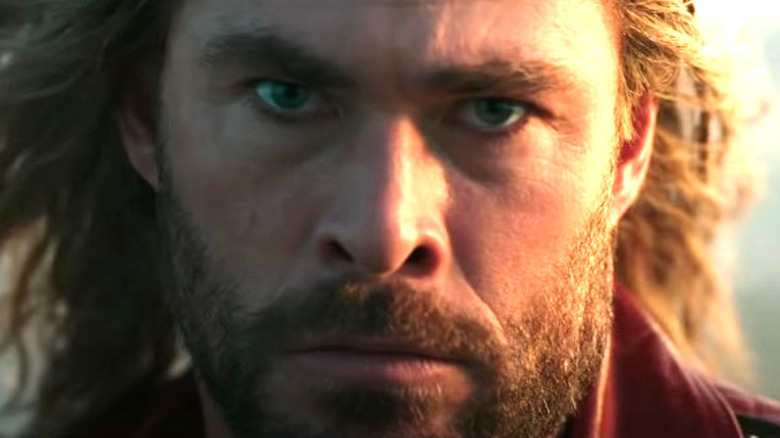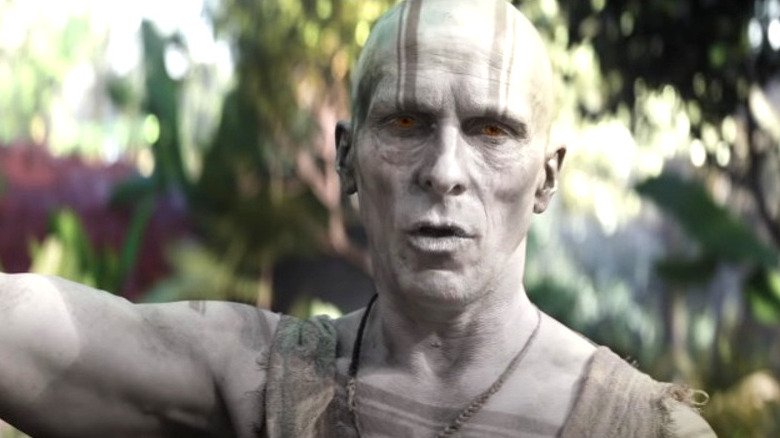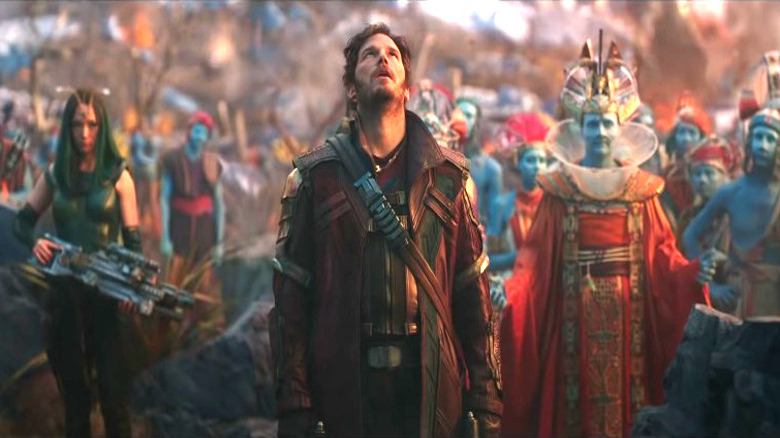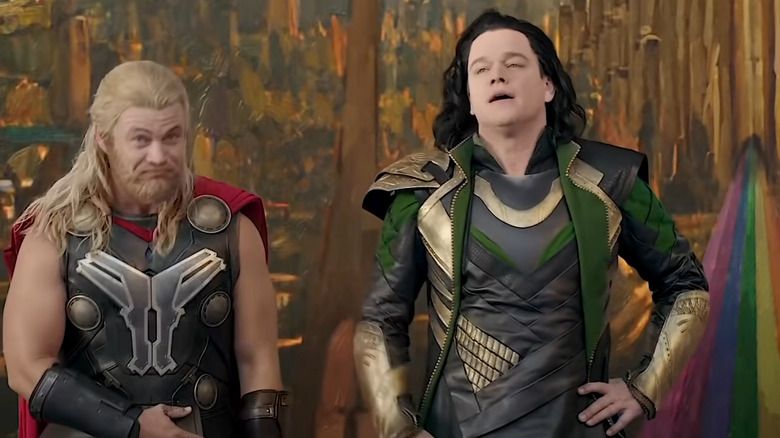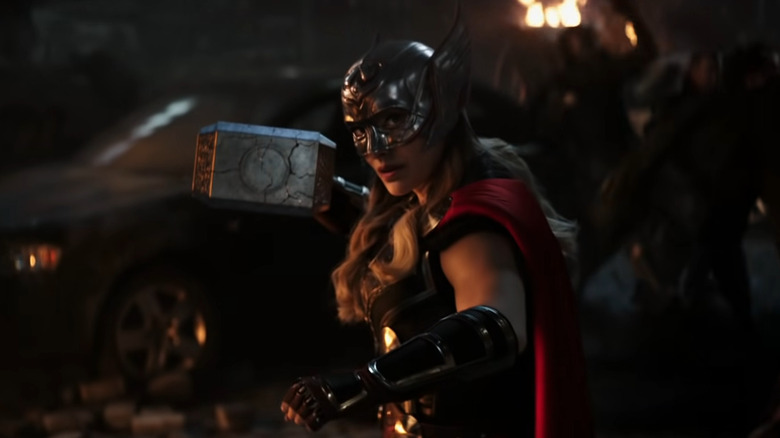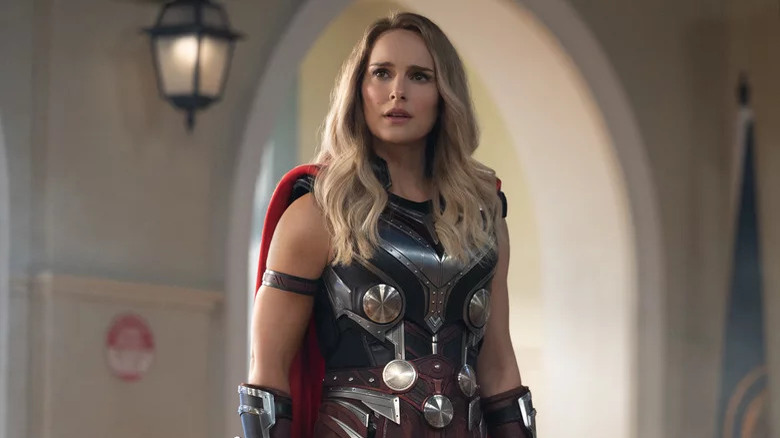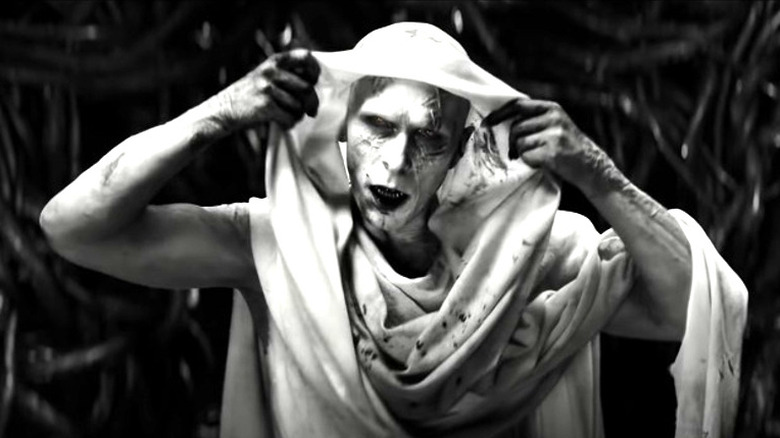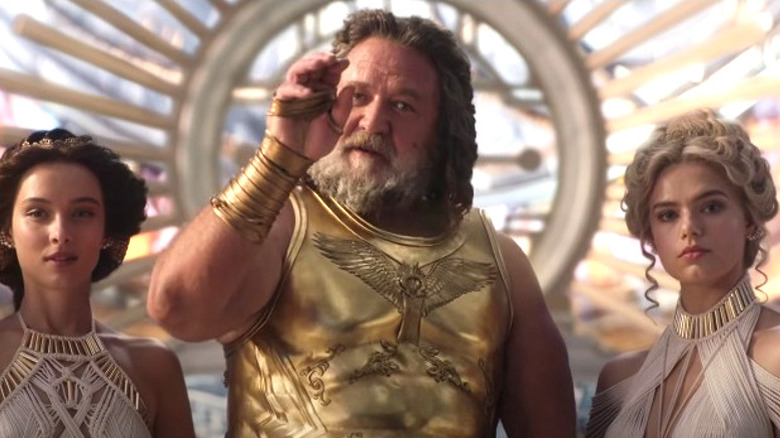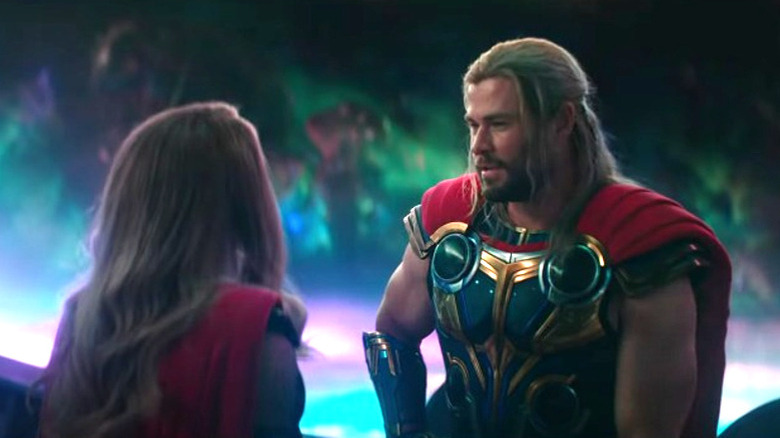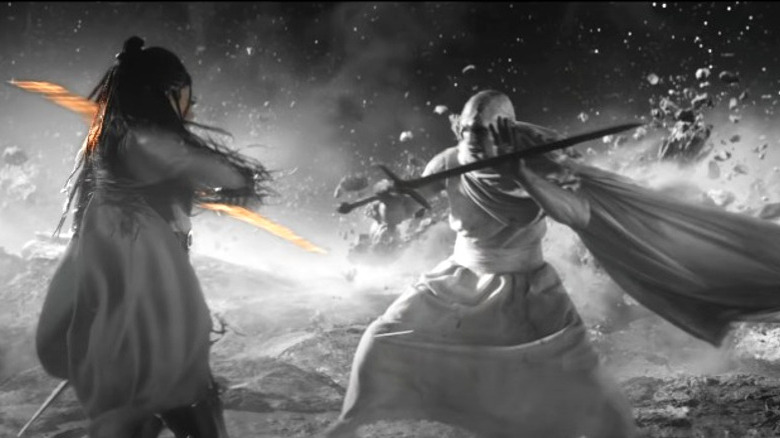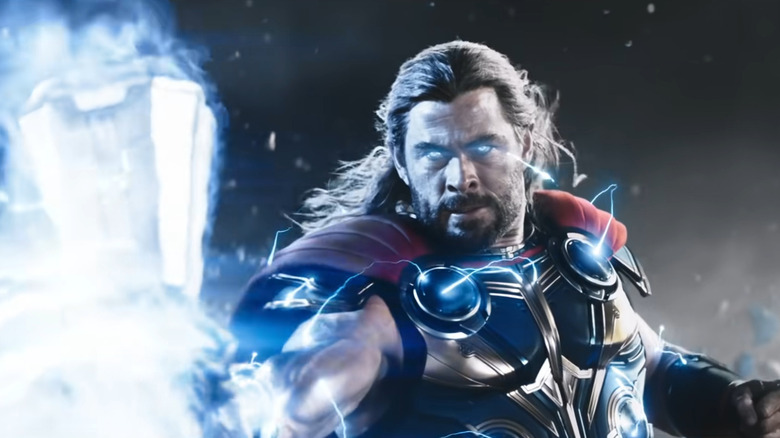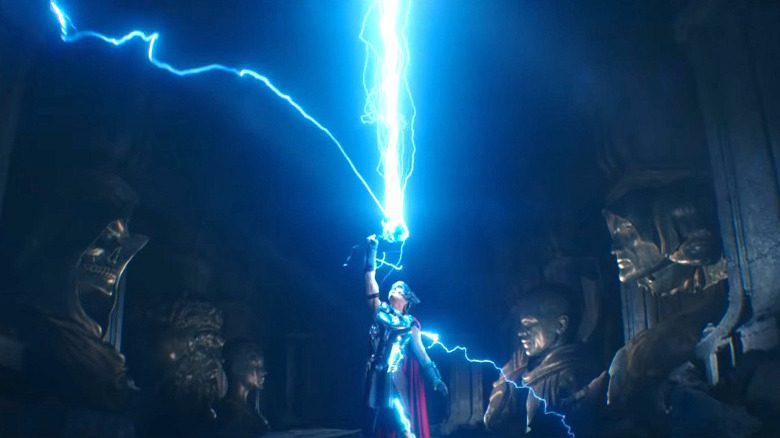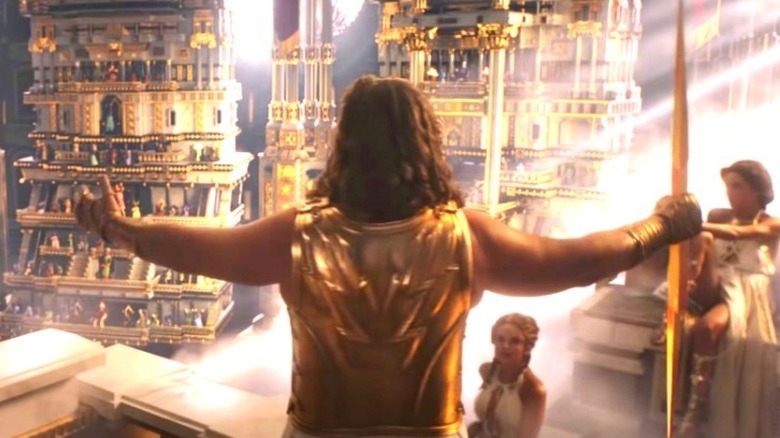Thor: Love And Thunder Scenes That Deserve A Second Watch
"Thor: Love and Thunder" is a film packed with incredible moments. From gigantic spectacle to hilarious comedic beats and grounded, emotional drama, this is a movie with pretty much everything you could ask for.
The progression of the "Thor" films has been fascinating. Starting with a strong, if simplistic, fish out of water story in 2011, both the character and the movies bearing his name have grown immensely. In "Love and Thunder," Thor has developed a sense of humor about himself while also growing up to realize he has nothing to live for. His journey in "Love and Thunder" is as much about saving kidnapped children and the various pantheons of gods as it is about finding purpose. With the help of his friends Korg, Valkyrie, and ex-girlfriend Jane Foster, the God of Thunder learns that being a hero isn't just about beating the bad guy — sometimes you have to sacrifice who you thought you were in order to protect the people who rely on you.
That arc would be enough to justify watching the film on repeat, but there are a few scenes that are worthy of a second (or third or fourth) viewing. Whether it's to appreciate the stylistic choices, admire the acting, or just marvel at the comedy and scope, all of these scenes stand out as the cream of the crop. Naturally, there are lots of big-time spoilers ahead.
Gorr in the desert
The opening to "Thor: Love and Thunder" is interesting for a couple of reasons. For one, it is practically silent. There's no Marvel logo or fanfare. The movie simply begins. It's a disorienting shot of the desert. As the camera rises and turns, we meet Christian Bale as Gorr. He isn't the God Butcher just yet. In this scene, he is just a desperate father seeking help from his god to save his daughter. It's uncharacteristically somber and does an excellent job of pulling you in.
Something else that makes it interesting is the fact that it's mirrored in the ending. When Gorr finally reaches his destination, he is surrounded by water. The camera does the same disorienting turn, and Gorr is finally able to die, knowing that his daughter will be looked after and taken care of. The opening is about death, and the ending is about life reborn at the feet of Eternity, and they compliment each other quite nicely.
It also sets up a strange connection between this film and "Star Trek V: The Final Frontier." That film also opens with a weathered bald man in the desert. Also, Gorr's goal is to reach the center of the universe and have his wish granted by the entity referred to as Eternity. That sounds suspiciously like Spock's half-brother Sybok's plan to meet God at the center of the galaxy. Coincidence? Perhaps. Watch both openings again, though, and you might see the connection.
A classic Thor adventure
All the high-flying, wacky adventure stuff you would expect from a Guardians of the Galaxy and Thor team-up occurs after Gorr's origin and a quick rundown of the previous films via a sweet voice-over from Korg. We learn that Thor is done wandering around the cosmos looking for people to save. Instead, he will sit and wait for someone to say that they need his help to win this battle.
Peter Quill says those exact words, and Thor rides on his ax Stormbreaker like the Wicked Witch in "The Wizard of Oz" before single-handedly defeating the enemy. It is a bonkers sequence filled with humor and incredible action. It's got lasers, Guns N' Roses, Jim Henson-esque creatures laughing and firing at Thor, a Jean-Claude Van Damme split, and it's a lot of fun. Watching this sequence is like seeing every '80s and early '90s nerd's dream of what a "Thor" movie should be come to life.
It isn't particularly insightful about the human condition, and it doesn't break a lot of new ground regarding superhero action, but it's an absolute blast. Why wouldn't you want to relive such a wild and invigorating sequence more than once?
The play's the thing
Jane Foster isn't holding up so well in "Thor: Love and Thunder." She's still a brilliant scientist using her intelligence to try and save the world, but she has also been diagnosed with stage IV cancer. Her old friends Darcy and Selvig are the only ones who know about her illness, and Darcy thinks Jane should reach out to Thor. While Jane doesn't want to do that, Thor's broken hammer Mjolnir is calling out to her.
Jane travels to New Asgard in Norway to find the hammer. While she's there, Asgardian actors (just like in "Thor: Ragnarok") are performing a scene from the previous scene. Matt Damon plays Loki, Sam Neill is Odin, and Chris Hemsworth's brother, Luke Hemsworth, portrays Thor. They're doing Odin's death scene and using every cheap stage production trick they can think of to pull it off.
The scene is worth a second viewing because it is hilarious (especially when Melissa McCarthy arrives as Hela) and because it sets up (or reintroduces) the idea that when a Norse god dies and enters Valhalla, they disappear in wisps of gold. This time, you can take in the funny performances and appreciate the foreshadowing of what will happen in the final act with Jane.
The new guy
It comes as no surprise (thanks to the trailers) that Natalie Portman's Jane Foster will be wielding the power of Thor. We also know that she will arrive during a battle happening at night and that Thor will be astonished to see her. However, the anticipation for this moment is so intense and the scene itself has so much going on that when it finally happens, you're thrilled.
The acceleration of the sequence is what really stands out. It begins with Gorr arriving at New Asgard. Using his new powers, he creates shadow creatures that eerily stretch all along the Asgardian streets. When they start attacking, Thor, Korg, and King Valkyrie are there to fight them off. During the battle, Thor hears a familiar sound. Looking around the chaos of battle, he sees his reconstructed Mjolnir.
Just as the hammer is about to reach his hand, it flies back to its current master: Jane Foster. Things turn into a violent and epic romantic comedy as the two banter a bit before Gorr goes on the attack. Then we learn this was all a ruse for Gorr to capture the children and hide them in the Shadow Realm. The seamless tonal shifts are very impressive, and the moment Jane allows Mjolnir to fly off in a few dozen pieces so it can take out a few monsters and reform in her hand a second later is so cool.
Jane destroys a sink
When she's in full Thor mode, Jane is powerful and confident. The people around her can't even tell that she's sick. When the powers go away, though, the effects of her cancer return with a vengeance. It's revealed later on that Mjolnir is actually draining her mortal energy, and as a result, her body lacks the strength to fight the illness. In a quiet scene following her meeting up with Thor, we see the toll her condition is taking on her mental state.
While standing alone in a bathroom, Jane looks at herself in the mirror. We see flashbacks to a time when her mother was sick. The memory of how her life was taken from her mom and the knowledge that the same is happening to her is too much to bear. Out of rage, she slams Mjolnir through the sink. What's so powerful about this scene is the subtlety and intimacy. She's not in the middle of an argument. She's not having a tantrum. For just a moment, her humanity slips out, and she gives in to the pain.
Part of the secret recipe that makes Marvel movies work so well is their emphasis on the humanity of their characters. Even when they're off saving the entire universe, we're more invested in their personal, internal journey than we are in the external. This scene and Portman's performance are a perfect reminder of that.
Out of the shadows
With Thanos, Marvel created someone who was multidimensional with a point of view you could understand, even though you probably don't agree with him. They've done this again in "Thor: Love and Thunder" in the form of Gorr the God Butcher. From his first appearance, you understand why he is so angry and vengeful. He was clearly a devoted disciple of a god who betrayed him with indifference.
That would be enough for us to understand him, but we empathize because he is so complicated. On a visual level, he looks haunted and creepy. However, Christian Bale's voice isn't heavy, deep, or raspy. In a few scenes, his voice is high-pitched, almost wounded. He acts like someone who could break into a Joker impression at any time, but the tragedy of his daughter's death and the weight of his curse prevent him from delighting in what he does.
For instance, take the scene in which he emerges from the shadows, intentionally terrifying the children he's captured by producing a creature and ripping its head off in a macabre display of dominance. He doesn't smile, he doesn't laugh. Instead, he looks sad, tired, and confused. It's worth watching again for the shock of how dark the moment is and to savor the nuances of the performance.
The entrance of Zeus
Since Gorr exists in the Shadow Realm, Thor and friends need to borrow Zeus' weapon, Thunderbolt, to fight the darkness. This brings them to the incredible Omnipotence City where all the gods (even Korg's) reside. Everything about this place deserves a rewatch because it is so beautiful and packed with Easter eggs and references that only multiple viewings can fully reveal.
The star of the show, though, is Russell Crowe as Thor's hero, Zeus. To call his performance over the top would be an understatement. He is devouring the scenery around him like an all-you-can-eat buffet and clearly loving every second of it. In a film this wacky, though, it absolutely works, and Crowe is an utter delight. Other than reveling in his hammy performance, the scene's progression is something to behold.
When Thor and co. take their seats, it's impossible to predict what's about to happen. As every second passes, something unexpected occurs, and everything builds to chaos — a fight between the gods breaks out, Thor runs Zeus through with his own lightning bolt, and giant screaming goats crash through a stained glass window. Whatever magic director Taika Waititi used to make all this madness hold together is certainly powerful stuff.
Making rock babies
During their visit to Omnipotence City, our heroes discover that Gorr's goal is to make it to the center of the universe in order to reach a being called Eternity. The legend says that the first person to reach Eternity will have their wish granted. Since Gorr's title is God Butcher, Valkyrie implies that his wish would be to wipe all gods out of existence. So, they journey to the Shadow Realm to save the children and stop Gorr from getting his wish.
In a quest story, this would usually be the part where everything slows down and the audience gets a little bored waiting for something to happen. "Thor: Love and Thunder" keeps things interesting by giving us cosmic vistas with space dolphins, some world-building regarding the reproductive process of Kronans (Korg's species), and a warm heart-to-heart between Thor and Jane.
Again, this is a scene balancing a lot of different tones and communicating important information. In the hands of a lesser filmmaker, this section of the film would have devolved into a slog, but Waititi's masterful handling of comedy, gravitas, and stunning visuals make it entertaining, enlightening, and rewatchable.
It's a trap!
Upon arriving in the Shadow Realm, all the color drains out of the film, except for Thunderbolt, which still crackles and sizzles with Zeus' power. The ominous nature of this mysterious place sets in right away, and Thor's friends are on the lookout for an ambush or any signs of the children they're looking for. While journeying through the tunnels deep within the dark moon, Jane uncovers Gorr's plan. He needs Stormbreaker to conjure Bifrost (the rainbow bridge) in order to open the gates to Eternity.
The fact that kidnapping the Asgardian children was all a ruse isn't surprising, but that's not the point of the scene. The reason this moment is so powerful is witnessing just how brutal Gorr can be. He moves through the shadows like a reanimated corpse. He speaks through sharp, rotten teeth, demanding Thor call his ax. When he refuses, Gorr uses the sentient shadows to wrap themselves around Valkyrie and Jane.
The shadow vines constrict tighter and tighter each time Thor refuses to call Stormbreaker. You can tell Gorr doesn't enjoy this, nor does he hate it. Torturing Thor and his comrades is just a necessary step in his plans. Some viewers may not wish to relive such an aggressively dark scene, but the strength of the performances should be enough to bring you back.
Children of Asgard
There was a time when the primary audience for superhero stories was kids. Adult fans may not like to admit this fact, but it's true. As new creators entered the comic book industry, they started updating their stories to reflect the times they were in and new storytelling conventions. Eventually, comics matured to a point where most parents probably wouldn't allow their kids to read them until reaching some mutually agreed-upon age.
We have lived in this paradigm for so long that it's easy to forget the more innocent origins of our favorite characters. Family and kid-friendly comics still exist, of course, but the vast majority of superhero films are aimed at older audiences. That is why it is so rewarding when Thor shares his powers with the kidnapped children. For the first time in an MCU movie, we see kids take on the bad guys, and it is pure, thrilling wish fulfillment.
As the song "November Rain" kicks into gear, these poor kids — who've been terrified of Gorr and his shadows through most of the movie — fight back. Lightning erupts from their eyes and weapons (even a stuffed animal) as they defeat their terrorizers and Thor does battle with Gorr. For anyone who fell in love with superheroes at a young age, this is a dream come true.
Facing eternity
Like the opening, the ending of "Thor: Love and Thunder" is surprisingly lacking in the epic battle sequence department — and we mean that in a good way. Marvel films have a habit of ending with two superpowered beings punching each other into exhaustion, and the one left standing is the victor. But "Love and Thunder" begins its climax that way before careening into uncharted territory for the MCU.
Gorr reaches Eternity. Jane is succumbing to her illness, and Thor doesn't know quite what to do. He can't hammer (or ax) his way out of this. Losing the love of his life and witnessing her make the ultimate heroic sacrifice, he decides to open his heart to Gorr. As a result, Gorr doesn't wish for the end of the gods. Instead, Eternity brings his daughter back. Thor, inspired by the villain's drive to honor his daughter at all costs, proves to him that the reason for living has always been there: love.
If you're tired of loud, raucous, and tedious finales, this ending should come as a breath of fresh air. Plus, it sets up the very ending where we finally learn why the film is called "Thor: Love and Thunder."
Roy Kent, Roy Kent!
Everyone knows to stick around during the credits of a Marvel movie. Since Nick Fury introduced himself to Tony Stark at the end of the original "Iron Man," it has become a tradition with each installment to stay in your seat and see what tease they have in store for the next movie. In the case of "Thor: Love and Thunder," we get two scenes. One lets us know that Jane made it to Valhalla where she is greeted by Heimdall. The other sets up a very exciting antagonist for the next film.
The scene begins with a wounded Zeus lamenting the public's lack of interest in the gods. He can remember a time when humans feared and worshiped them. Now, all they care about are superheroes. Fed up with this fall from grace, he vows to make them fear the gods once again. The suggestion that a new "Thor" movie featuring gods terrorizing humanity is cool enough, but the final reveal is the real kicker.
It turns out that Zeus wasn't simply soliloquizing — he was giving orders to his son Hercules. Then we see that Brett Goldstein (Roy Kent from "Ted Lasso") is playing the legendary son of Zeus. As cool as that is, he also looks like the living embodiment of a Jack Kirby drawing. Watching the son of Odin and the son of Zeus duke it out is going to be a blast, and this scene builds the hype perfectly.
